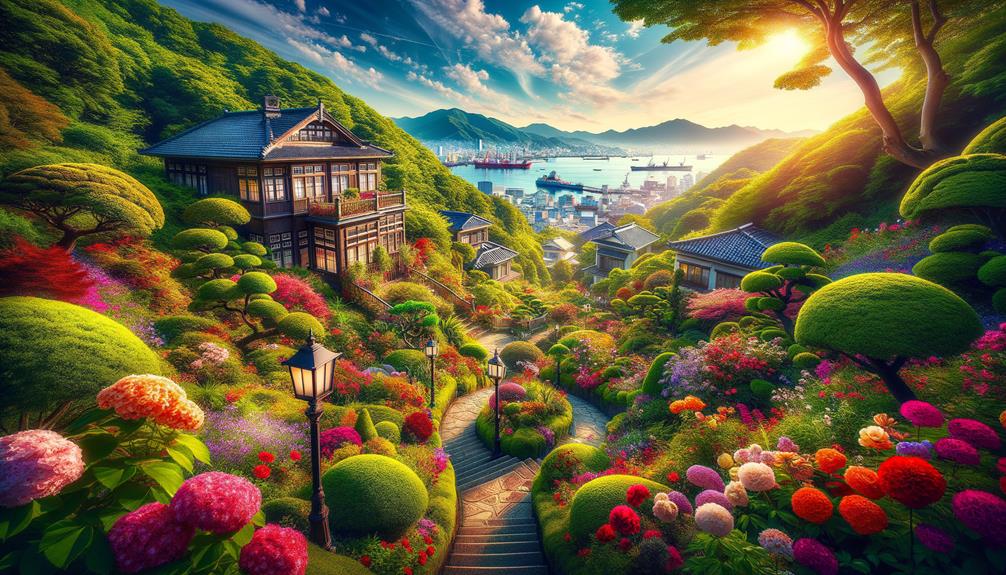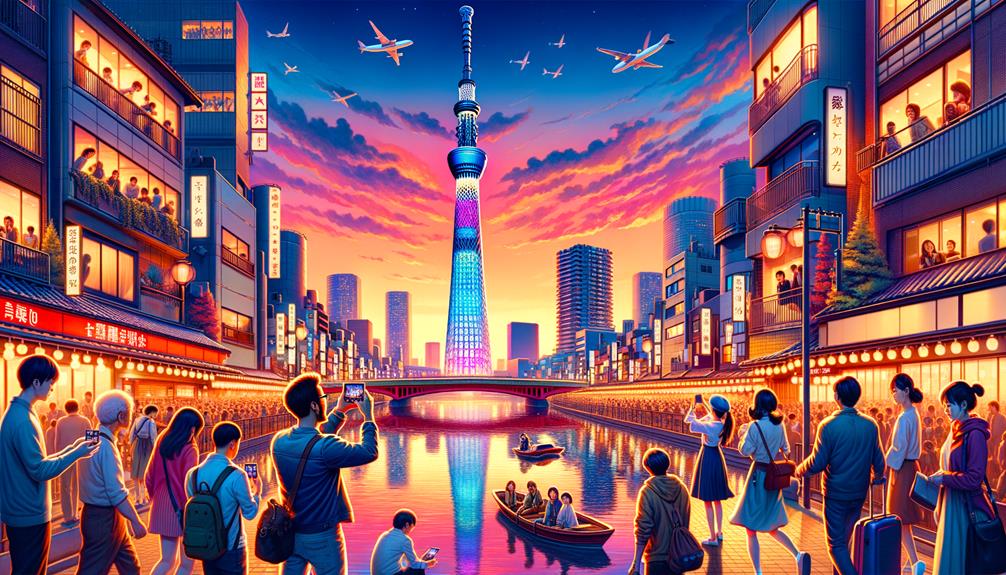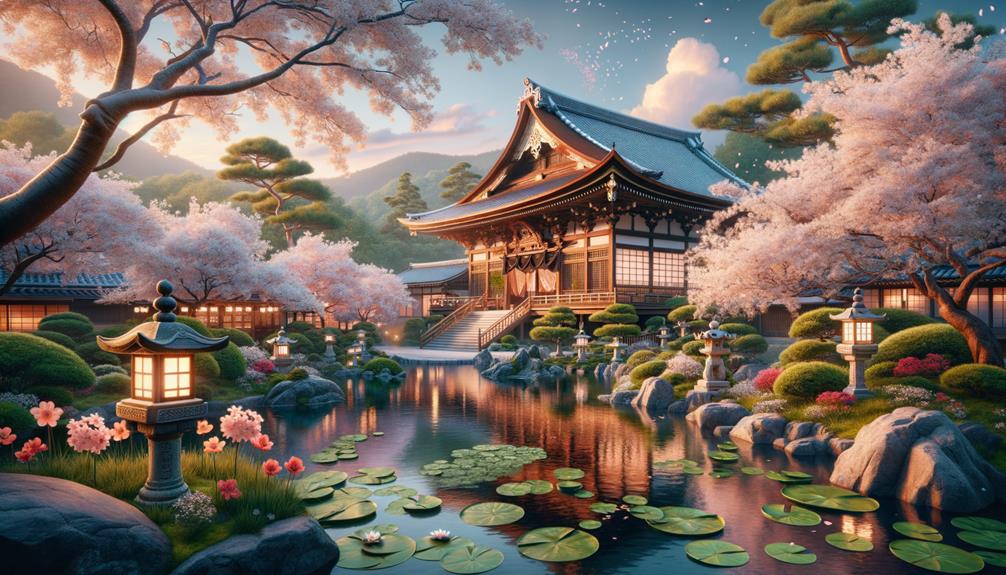Wandering through Nagasaki Glover Garden is like stepping into a historical novel where East meets West, blending architectural styles and cultural influences. The preserved wooden buildings, like the famous Glover House, offer a direct link to the late Tokugawa Shogunate period. Thomas Glover's impact goes beyond architecture; he played a significant role in Japan's industrial and political changes. The garden's hilltop views and intricate features invite further exploration, showcasing the harmonious mix of styles and histories that make this place special.
Historical Context
Walking through Glover Garden, it's like stepping back into the late Tokugawa Shogunate period, when Western merchants were a common sight in Nagasaki. The air is filled with a sense of history, a blend of cultures that have shaped modern Japan. The preserved wooden buildings, some of the oldest in Japan, serve as reminders of a transformative era. Each structure, especially the Glover House, tells stories of a time when Western and Japanese influences began to merge.
The Glover House, known as Ipponmatsu, stands out with its mix of Western and Japanese architectural styles. It's more than just a building; it's a symbol of cultural exchange and adaptation. The Western-style verandas and Japanese tatami rooms coexist seamlessly, reflecting the innovative spirit of Thomas Blake Glover. He aimed to create a space where two worlds could meet, looking beyond just business.
Wandering deeper into the garden, I think about the importance of this place. Glover Garden isn't just a historical site; it's a living story of cross-cultural interactions. This space invites you to look closer, to understand how Western influence took root on Japanese soil.
Thomas Glover's Legacy
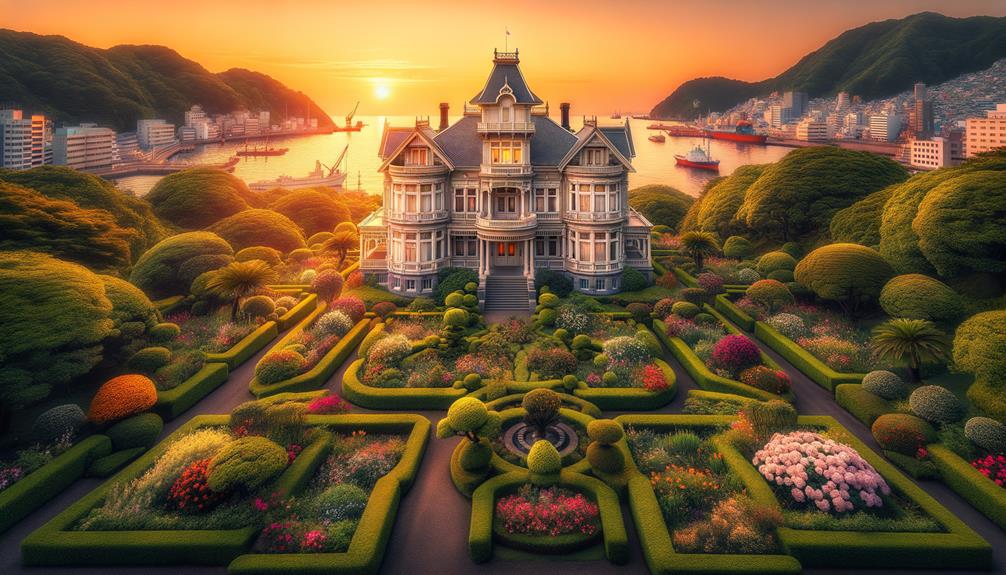
Strolling through Glover Garden, it's impossible not to be amazed by how deeply Thomas Glover's mark is embedded in Nagasaki. His role in Japan's industrial era, from helping establish Mitsubishi to introducing Kirin Beer, is incredibly significant. The beautiful architecture of his home and his connections with anti-Shogunate samurai highlight a legacy that has profoundly influenced the city's landscape and history.
Industrialization and Trade Contributions
Thomas Glover's efforts in establishing Mitsubishi and Kirin Beer were pivotal in Japan's journey toward industrialization and international trade. Walking through Nagasaki and reflecting on Glover's influence, it's clear that his arrival in 1859 set the stage for Japan's modernization. His ventures weren't just about building businesses; they connected Japan with the Western world. By founding Mitsubishi, Glover laid the foundation for a company that would become an industrial giant, boosting Japan's production capabilities and technological advancements.
Glover's creation of Kirin Beer further illustrates his impact. By introducing Western brewing techniques, he didn't just start a popular brand—he also facilitated cultural exchange between Japan and the West. His support for anti-Shogun factions and promotion of overseas travel challenged Japan's isolationist policies of the time, fostering openness and innovation.
Standing in Glover Garden, the legacy of Thomas Blake Glover's contributions to trade, industry, and cultural exchange in Nagasaki is evident. The garden isn't just a tourist spot; it's a testament to a man whose vision and actions helped shape modern Japan, teaching us the importance of challenging norms and embracing global connections.
Architectural Influence and Design
Exploring Glover Garden, I'm amazed by how well Western and Japanese architectural styles blend together in the Glover House. The house features a unique arch-shaped eave and a tile-covered roof, showcasing Thomas Blake Glover's vision. It's incredible how he combined Western-style buildings with traditional Japanese design, creating something truly unique.
Walking through the Glover House, its historical importance is clear. As the oldest Western-style house still standing in Japan, it highlights Glover's lasting impact on the country's architecture. The design not only reflects his personal taste but also marks a pivotal moment in Japanese history when Western and Japanese cultures started to merge more deeply.
The Glover House is more than just a building; it's a testament to innovation and cultural fusion. Glover's influence on Japan's industrialization is evident not just in factories and shipyards but also in the very structure of this home. Every detail, from the Western-style verandas to the Japanese garden elements, prompts reflection on how one man's vision can shape a nation's architectural heritage.
Relationship With Anti-Shogunate Samurai
Few relationships in history weave together personal ambition and national change quite like Glover's connection with the anti-Shogunate samurai. In 1863, Thomas Glover played a pivotal role in Japanese history by helping the Choshu 5 secretly travel to the United Kingdom. Japan's strict ban on overseas travel at the time made this a bold and illegal move. Still, Glover saw the potential for these men to drive significant change.
Once in the UK, the Choshu 5 immersed themselves in Western knowledge and returned to Japan with fresh ideas that would later shape the Meiji government. They were deeply grateful to Glover, and his influence on their thinking was clear. This relationship wasn't merely about opposing the Shogunate; it was about introducing Western ideas to a nation on the cusp of transformation.
Glover's support for the anti-Shogunate factions shows he was more than just a businessman. He played a crucial role in Japan's modernization, helping to exchange ideas and technologies. His legacy, commemorated at Glover Garden, stands as a testament to his significant part in Japan's shift from isolation to global interaction.
Architectural Highlights

It's truly intriguing to see how the Glover House effortlessly combines Western and Japanese architectural styles. The arch-shaped eave and tile-covered roof highlight this rich blend of cultures. Nestled in the tranquil Glover Garden, this house offers a fascinating peek into history. Built in 1863 by Thomas Blake Glover, it's the oldest standing Western-style house in Japan.
Walking through the octagonal stone-floored veranda, you can almost sense Glover's lasting impact on Nagasaki's architectural landscape. The skilled craftsmanship of carpenter Shu Koyama, who blended Western and Japanese techniques, showcases this cultural mix beautifully.
| Architectural Feature | Description |
|---|---|
| Arch-shaped eave | Blends Western and Japanese styles seamlessly |
| Tile-covered roof | Highlights traditional Japanese design |
| Octagonal stone-floored veranda | Unique and elegant space |
| Hidden attic room | Used for secret meetings |
The hidden attic room, rumored to have hosted secret meetings, adds a layer of mystery and intrigue. These elements make the house more than just a historical site; it stands as a testament to the creativity and innovation of its time. The lush surroundings of Glover Garden enhance this feeling, making each step feel like a walk through history.
Key Attractions
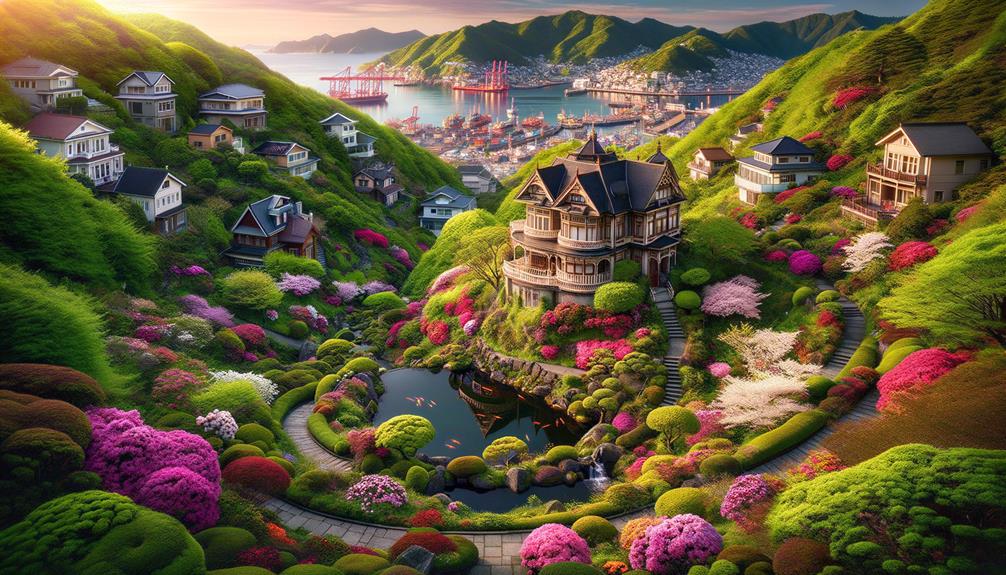
Walking through Glover Garden, I felt a unique blend of historic Western architecture and traditional Japanese features. The charming Glover Residence and the stunning hilltop views of Nagasaki Harbor each told a story of cultural fusion. The Madame Butterfly House, whimsically named, added a touch of operatic romance to the visit.
Historic Western Architecture
Glover Garden in Nagasaki offers a unique look into the blend of Western and Japanese architecture from the early days of foreign settlement in Japan. As I stroll around, I'm immediately taken by the charm of the historic buildings, especially the renowned Glover House. Built in 1863 by Scottish trader Thomas Glover, this house is the oldest surviving Western-style house in Japan. Its design is intriguing, merging Western elements with Japanese touches, like the arch-shaped eave and tile-covered roof.
Moving deeper into the garden, I come across the former Ringer House, another highlight here. These homes provide a snapshot of the lives of English merchants who once lived in Nagasaki. The architecture of these buildings reflects the cultural exchange that shaped the city's history.
| Key Attractions | Features | Insights |
|---|---|---|
| Glover House | Blend of Western and Japanese | Oldest Western-style house in Japan |
| Former Ringer House | English merchant residence | Reflects foreign influences in Nagasaki's history |
| Various Buildings | Schools, restaurants, dock houses | Showcase early Western settlement architecture |
Walking through these historic homes, I get a sense of the freedom and spirit of the people who bridged the East and West.
Scenic Hilltop Views
There's nothing quite like the stunning view from the hilltop at Glover Garden. Nagasaki Harbor and the city spread out beneath you in an amazing panorama. Standing there, you feel a sense of freedom as the wide expanse of the harbor meets the urban landscape. The views are absolutely captivating, offering a unique way to appreciate both nature and architecture.
Wandering through the beautiful gardens, I was drawn to the former Mitsubishi No. 2 Dock House. This historic building, perched high on the slope, provides another angle on the hilltop views. It shows how Western settlers influenced Nagasaki's architectural evolution. The mix of traditional Japanese elements and Western-style buildings is truly fascinating.
Every step through Glover Garden's hillside setting reveals more of its charm. The blend of lush greenery and well-preserved residences creates a serene environment, perfect for reflection. It's a place where history and nature coexist, inviting you to pause and take in the world from above. The views here offer a sense of escape and a reminder of the beauty found in freedom and exploration.
Cultural Heritage Sites
Tucked away in the charming Glover Garden, the Glover Residence stands as Japan's oldest surviving Western-style house, a testament to the rich cultural heritage of this historic site. As I strolled through this remarkable area, I couldn't help but be captivated by its unique blend of Japanese and Western architectural styles. Glover Garden is one of Nagasaki's most visited cultural heritage sites, celebrated for its sweeping views of Nagasaki and its historical significance as the former Mitsubishi second dock house.
Walking through the grounds, I felt enveloped by history, with each building offering a window into a different era. The Glover Residence itself embodies a fusion of cultures, resembling bungalows from Hong Kong or Shanghai. Nearby, the Glover Garden Tea House, known as the first Western-style restaurant in Japan, invites visitors to pause and enjoy the tranquil atmosphere.
One of the garden's standout features is the Madame Butterfly House, named for its resemblance to the setting of Puccini's opera. Standing there, I felt a deep connection to the past, as if experiencing the world through the eyes of those who once lived and worked in this vibrant, historical enclave.
How to Get There
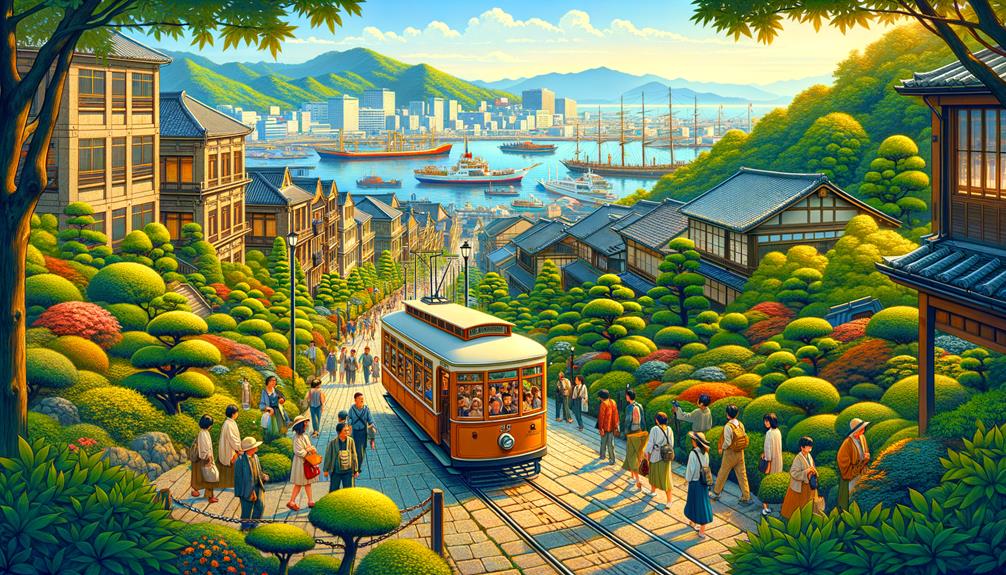
Getting to Glover Garden is pretty simple and adds to the charm of the visit. A short walk from the Ouratenshudo tram stop brings you to the peaceful entrance of Glover Garden, which sits right next to Oura Church. As you walk there, the cobblestone streets and unique architecture of Nagasaki make you feel like you're stepping back in time.
The tram system in Nagasaki is easy to use and dependable, perfect for those who like a bit of spontaneity. Once you get off at the Ouratenshudo stop, you'll find clear signs pointing you in the right direction. The brief walk gives you a moment to soak in the surroundings and get ready for the beauty that awaits at Glover Garden.
Here are some tips for your visit:
- Know Your Route: Check out the tram lines and stops beforehand to make your journey smoother.
- Wear Good Shoes: The walk includes some slopes and cobblestone streets, so comfortable shoes are a must.
- Bring a Camera: You'll want to capture the stunning views and architecture of Glover Garden and Oura Church.
This short trip sets the stage perfectly for the delights you'll find at Glover Garden.
Visiting Hours and Fees
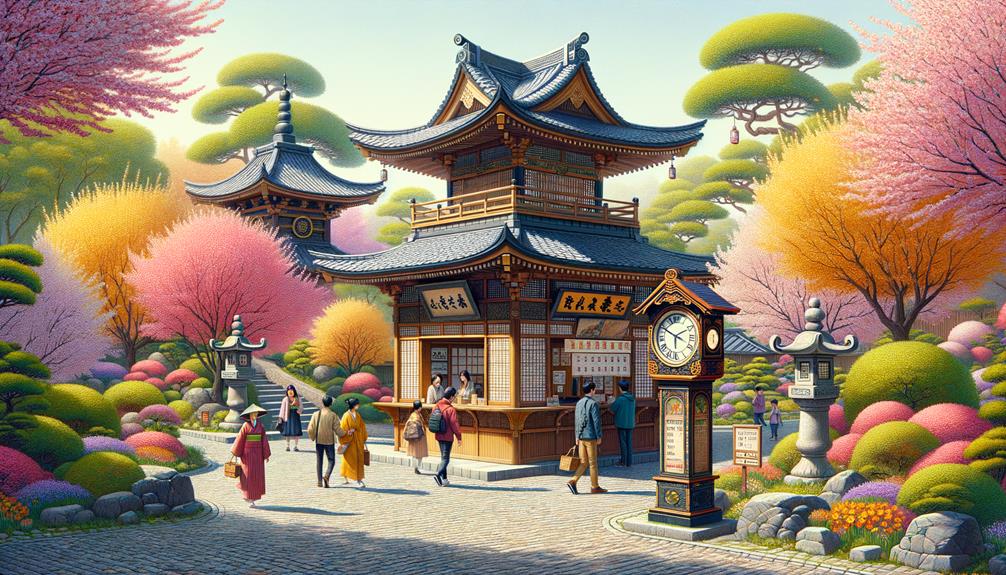
If you're planning a visit to the charming Glover Garden, you'll be pleased to know it's open every day from 8:00 am to 6:00 pm, with extended hours until 8:30 pm on Saturdays. These hours give you plenty of time to soak in the garden's beauty and historical significance. The entrance fee is 620 yen for adults, which is quite reasonable for the experience.
Located at 8-1 Minamiyamatemachi in Nagasaki, Glover Garden is easy to get to from the Ouratenshudo tram stop. The journey there feels like a prelude to the adventure that awaits. As I wandered through Glover Garden, I was struck by the well-preserved Western-style buildings and lush, hilltop gardens. Each part of the garden tells a story, from the old residences to the dock houses.
The Glover Garden Tea House, famous as Japan's first Western-style restaurant, is a testament to the cultural blend that makes this place unique. Visiting Glover Garden is more than just a tour; it's a step back in time.
Dining and Souvenirs

Discovering the dining and souvenir options at Glover Garden, I enjoyed a blend of traditional flavors and unique keepsakes that perfectly capture Nagasaki's rich heritage. As I wandered through the charming souvenir shops, I couldn't resist picking up a box of Nagasaki's famous castella cake. This sponge cake, with its Portuguese origins, offered not just a sweet treat but a taste of history.
For a savory delight, I indulged in kakuni manju, a delectable pork belly bun that melted in my mouth. The rich, tender meat paired perfectly with the soft, steamed bun, making it an unforgettable culinary experience. With each bite, I felt connected to the city's vibrant culinary traditions.
Beyond the food, the Glover Cosplay rentals caught my eye. For just JPY 600, I could step back in time and wear a period outfit, adding a playful twist to my visit.
- Must-try dessert: Nagasaki's castella cake
- Local dish to savor: Kakuni manju
- Unique experience: Glover Cosplay outfit rentals for JPY 600
Reflecting on my visit, I realized that Glover Garden isn't just a place to see; it's a place to taste and treasure Nagasaki's cultural and culinary heritage.
Scenic Views and Experiences
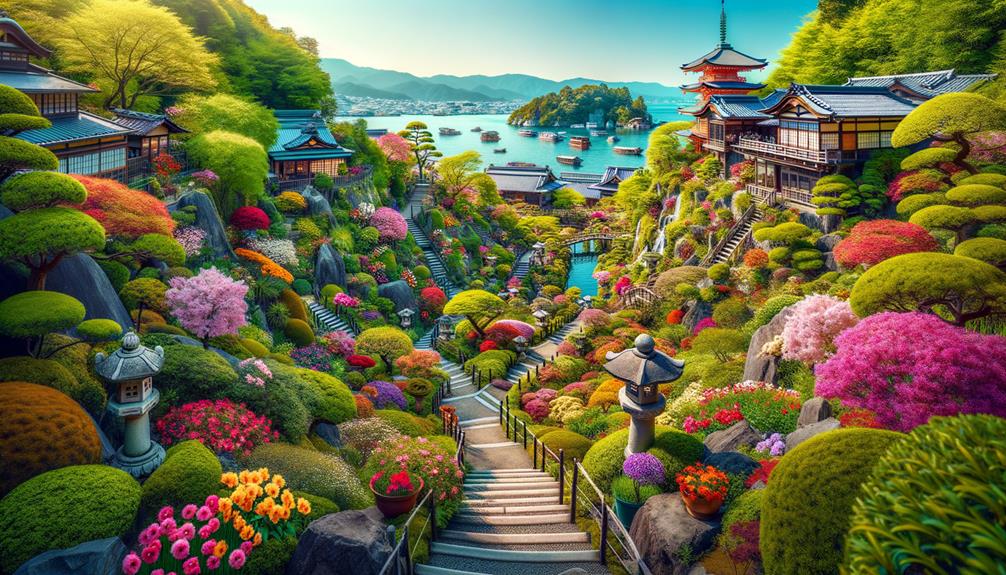
Walking through Glover Garden, I was struck by the beautiful mix of Japanese and Western architecture, all set against the sparkling waters of Nagasaki Harbor. Glover Garden is one of Nagasaki's most popular attractions, and it's easy to see why. Each step offered a new view, revealing historic Western-style buildings among perfectly kept gardens.
The Glover Residence stood out, its Western style blending seamlessly with the Japanese surroundings. From the hilltop, the panoramic views of Nagasaki Harbor were simply breathtaking. The entrance fee of JPY 620 seemed like a small price for such an immersive experience. As I wandered the paths, vibrant flowers and lush greenery surrounded me, creating a peaceful escape from the busy city below.
I paused at the Glover Garden Tea House, Japan's first Western-style restaurant, to enjoy not just the food but also the unique cultural mix that defines this place. As the sun set, the garden turned into a canvas of warm colors, making it an unforgettable experience. Glover Garden truly captures the essence of Nagasaki's rich history and scenic beauty.
Frequently Asked Questions
Is Glover Garden Worth Visiting?
I think Glover Garden is definitely worth a visit. The blend of different cultures, the stunning views of the harbor, and the historical atmosphere make it a refreshing place to spend some time. It's a nice mix of old and new, perfect for anyone looking to enjoy some freedom and relaxation.
Why Was the Glover Garden Created?
The Glover Garden was established to honor Thomas Blake Glover's legacy. Walking through its historic Western-style homes, I thought about the rich cultural exchange and the significant role he played in Japan's industrial growth.
How Do I Get to Nagasaki Park?
To get to Nagasaki Park, start at the Ouratenshudo tram stop. From there, follow the scenic path that captures the historic charm of the area. It's a short and easy walk, and the experience is incredibly refreshing.

